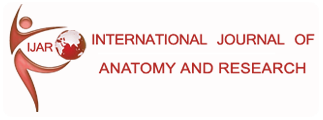
Quick Links


Archives


How
to
cite
this
Article:
Sayantani
Majumdar,
Sreya
Moitra,
Nidhi
Lal.
A
COMPARATIVE
STUDY
BETWEEN
INCIDENCE
OF
CHROMOSOMAL
ABNORMALITIES
IN
SPONTANEOUSLY
ABORTED
FETAL
SAMPLES
OF
ART
AND
NON-ART
ORIGIN.
Int
J
Anatomy
Res
2016;4(4):3298-3301.
DOI: 10.16965/ijar.2016.466.
Type of Article: Original Research
DOI: http://dx.doi.org/10.16965/ijar.2016.466
Page No.: 3298-3301
A
COMPARATIVE
STUDY
BETWEEN
INCIDENCE
OF
CHROMOSOMAL
ABNORMALITIES
IN
SPONTANEOUSLY
ABORTED FETAL SAMPLES OF ART AND NON-ART ORIGIN
Sayantani Majumdar *
1
, Sreya Moitra
2
, Nidhi Lal
3
.
*1,3
Demonstrator, Department of Anatomy, College of Medicine & Sagore Dutta Hospital, Kolkata, West Bengal, India.
2
Assistant Professor, Department of Anatomy, College of Medicine & Sagore Dutta Hospital, Kolkata, West Bengal, India
Address
for
correspondence:
Dr.
Sayantani
Majumdar,
Demonstrator,
Department
of
Anatomy,
College
of
Medicine
&
Sagore
Dutta
Hospital,
Kolkata,
West
Bengal 700058, India
E-Mail:
drsayantani727@gmail.com
ABSTRACT
Objective:
Spontaneous
abortions
are
quite
frequent
among
the
reproductive
age
group
of
our
country.With
the
advent
of
fast
life,infertility
has
become
a
major
issue
and
artificial
reproductive
techniques
are
often
the
resort
taken.
This
study
aims
to
throw
some
light
on
the
strength
of
association
of
chromosomal abnormalities with artificial reproductive technique.
Design
and
participants:
A
cross
sectional
study
was
done
on
50
aborted
fetal
samples
of
both
first
and
second
trimesters
in
a
Government
Medical
College,Kolkata.
Settings:
The samples were put to collagenase action,cultured and karyotyped to see the incidence of chromosomal abnormality.
Main
Outcome
Measures
and
results:
It
was
seen
that
karyotype
abnormality
is
present
in
36.4%
cases
which
applied
ART
in
comparison
to
incidence
of
chromosomal abnormality being 43.6% in case of normal pregnancies.
Conclusion:
So
it
is
seen
that
Artificial
reproductive
technique
did
not
seem
to
have
strong
association
with
the
incidence
of
chromosomally
abnormal
fetus.
KEY WORDS:
Artificial reproductive techniques,chromosomal abnormality,aborted fetal samples,karyotyping.
References
1
.
Manorama Thomas. Cytogenetic basis of recurrent abortions, Perinatology 1999;1(4):181-187.
2
.
Simpson and Golbus. Genetics of Pregnancy Losses, Genetics in Obstetric and Gynecology: 181-200.
3
.
Hassold TJ, Chen N, Funkhouser J et al.: A cytogenetic study of 1000 spontaneous abortions. Ann Hum Genet 1980;44:151-178.
4
.
Byrne J, Warburton D, Kline J, Blanc W, Stein Z: Morphology of early fetal death and their chromosomal characteristics. Teratology 1985;32:297-315.
5
.
Griffin
DK,
Millie
EA,
Redline
RW,
Hassold
TJ,
Zaragoza
MV:
Cytogenetic
analysis
of
spontaneous
abortions:
comparison
of
techniques
and
assessment
of the incidence of confined placental mosaicism. Am J Med Genet 1997;72:297-301.
6
.
Gita arjun , Recurrent Early Pregnancy Loss, An Introduction to Genetics and Fetal Medicine , editor Kamini Rao:27-30.
7
.
Lawler
AM,
Gearhart
JD.
Genetic
counseling
for
patients
who
will
be
undergoing
treatment
with
assisted
reproductive
technology.
FertilSteril.
1998;70:412-3.
8
.
Kavalier F. Investigation of recurrent miscarriages. BMJ. 2005;331: 121–2.
9
.
Christiansen
OB,
Nielsen
HS,
Kolte
AM.
Future
directions
of
failed
implantation
and
recurrent
miscarriage
research.
Reprod
Biomed
Online.
2006;13:71-83.
1
0
.
Harper JC, Delhanty JD, Handyside AH. Preimplantation genetic diagnosis. New York: John Wiley and Sons; 2000.
1
1
.
Diemer T, Desjardins C. Developmental and genetic disorders in spermatogenesis. Hum Reprod Update. 1999;5:120-40.
1
2
.
Gianaroli
L,
Magli
MC,
Munne
S,
Fiorentino
A,
Montanaro
N,
Ferraretti
AP.
Will
preimplantation
genetic
diagnosis
assist
patients
with
a
poor
prognosis to achieve pregnancy? Hum Reprod.1997;12:1762-7.
1
3
.
Royal
College
of
Obstetricians
and
Gynaecologists.
The
investigation
and
treatment
of
recurrent
miscarriage.
Guideline
No
17.
London:
RCOG
Press;
2003.
1
4
.
Mitelman F, editor. ISCN: An international system for human cytogenetic nomenclature. Basel: S. Karger; 1995.
1
5
.
Khudr G. Cytogenetics of habitual abortion: A review. ObstetGynecolSurv. 1974;29:299-310.
1
6
.
Pescia
G,
Jotterand
M,
Gaid
AC.
Early
repeated
abortion
and
karyotypes,
a
cytogenetic
study
of
80
consecutive
couples.
J
GynecolObstetBiolReprod.
1997;8:35-8.
1
7
.
Palanduz
S,
Ustek
D,
Karman
B,
Oztürk
S,
Cefle
K,
Başaran
S.
An
unusual
translocation
between
12tel
and
14q11
in
a
large
kindred.
Hereditas.
1998;128:231-4.
1
8
.
Al Hussain M, Al Nuaim L, Abu Talib Z, Zaki OK. Cytogenetic study in cases with recurrent abortions in Saudi Arabia. Saudi Med. 2000;20:233-6.
1
9
.
Mohammed
F,
Al-Yatama
F,
Al-Bader
M,
Tayel
SM,
Gouda
S,
Naguib
KK.
Primary
male
infertility
in
Kuwait:
A
cytogenetic
and
molecular
study
of
289
infertile Kuwaiti patients. Andrologia. 2007;39:87-92.
2
0
.
Butler M, Hamill T. Blood specimens from patients referred for cytogenetic analysis: Vanderbilt university experience. South Med J. 1995;88:309-14.
2
1
.
Fryns
JP,
Van
Buggenhout
G.
Structural
chromosome
rearrangement
in
couples
with
recurrent
fetal
wastage.
Eur
J
ObstetGynecolReprod
Biol.
1998;81:171-6.
2
2
.
Gutierrez-Mateo
C,
Gadea
L,
Benet
J,
Wells
D,
Munne
S,
Navarro
J.
Aneuploidy
12
in
a
Robertsonian
(13;14)
carrier:
Case
report.
Hum
Reprod.
2005;20:1256-60.
2
3
.
Raziel
A,
Friedler
S,
Schachter
M,
Kasterstein
E,
Strassburger
D,
Ron-El
R.
Increased
frequency
of
female
partner
chromosomal
abnormalities
in
patients with high-order
implantation failure after in vitro fertilization. FertilSteril. 2002;78:515-9.
Volume 4 |Issue 4.3 | 2016
Date of Publication: 31 December 2016






































